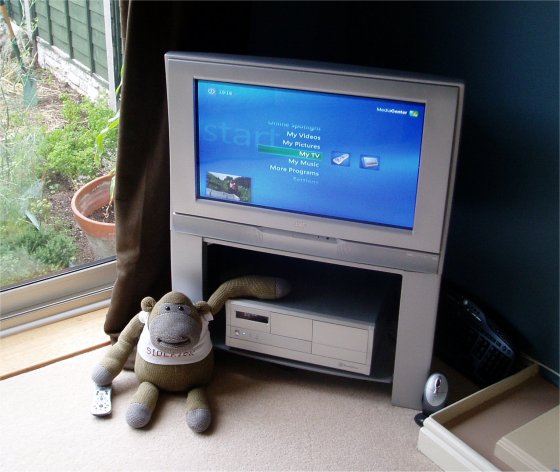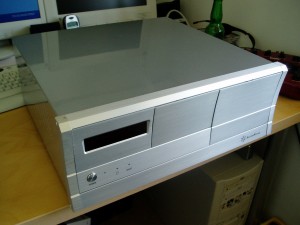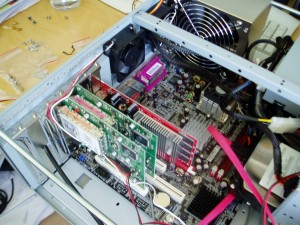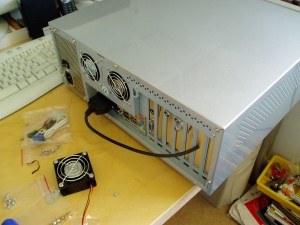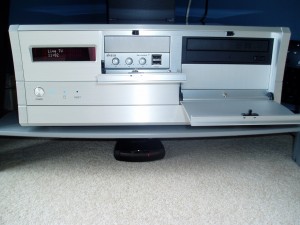Originally written around sometime in 2006, this page describes my original project to build a quiet PC to run Windows XP Media Center Edition. Since then I’ve upgraded to Windows Vista Media Center – the changes I’ve made to the PC to run Windows Vista are detailed over on this page but most of the PC remains the same.
Introduction
 This all started when we moved into our new house and, after unpacking most of the furniture, I realised there wasn’t really anywhere easy to put the hi-fi in the lounge! “Hmmm,” I thought, “maybe this is the excuse I need to get one of those slick new wireless media players and a hi-fi amp to sit underneath the telly…?” Well, I could have done that, but instead I started the magical life-changing journey that is a DIY Media Center PC
This all started when we moved into our new house and, after unpacking most of the furniture, I realised there wasn’t really anywhere easy to put the hi-fi in the lounge! “Hmmm,” I thought, “maybe this is the excuse I need to get one of those slick new wireless media players and a hi-fi amp to sit underneath the telly…?” Well, I could have done that, but instead I started the magical life-changing journey that is a DIY Media Center PC
As more and more people use digital media (photos, videos, music files…) around the house, new devices have started to appear that bring these together in the living rooms of our WiFi-enabled homes. This has coupled with the new digital TV onslaught and you can now choose from a wide range of hard-disk video recorders, wireless music players and other devices that purport to be “all-in-one” solutions for the digital living room. While I was mulling this over with a friend one day, she pointed out that perhaps I should build a PC that can do the lot – receive and record TV, play DVDs, video files, music, photos, everything – all in one box. I’d built plenty of PCs in the past and even had enough spare parts knocking around to put together a fairly capable PC. And so the journey began…
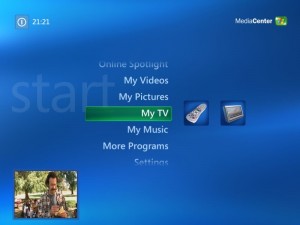 I started searching Google to see what other people had done in the area of Media PCs and Home Theatre PCs (HTPCs). Probably the best introduction I found was this Home Theatre PC Guide which basically made my mind up about what software it would run. I’d never seriously messed with Linux before so that ruled out MythTV. Personally, I think BeyondTV and SageTV both look a little too much like serious Windows applications to fit easily into my living room. Conversely, Microsoft has clearly spent a lot of effort with the look of Windows XP Media Center Edition (MCE). If this is going centre-stage in my living room it has to look good and, as you can see from this fancy interactive demo, Windows XP MCE looks good!
I started searching Google to see what other people had done in the area of Media PCs and Home Theatre PCs (HTPCs). Probably the best introduction I found was this Home Theatre PC Guide which basically made my mind up about what software it would run. I’d never seriously messed with Linux before so that ruled out MythTV. Personally, I think BeyondTV and SageTV both look a little too much like serious Windows applications to fit easily into my living room. Conversely, Microsoft has clearly spent a lot of effort with the look of Windows XP Media Center Edition (MCE). If this is going centre-stage in my living room it has to look good and, as you can see from this fancy interactive demo, Windows XP MCE looks good!
OK, when I first started writing this page I was going to give a narrative of my (long) journey from start to…well, uh, where I am now! Actually, to do this would produce a rather long rambling page (even worse than my HSH guitar wiring page! ![]() ). I started out trying to build this PC mainly out of spare bits I had lying around the house. It worked to some extent but Windows XP MCE is notoriously fickle about hardware drivers. This, coupled with a few hardware failures led me a merry dance through replacing just about every piece of hardware and God knows how many re-installs of Windows. It’s been a while now but I reckon I could still re-install and setup Windows XP MCE with my eyes closed… anyway, I’m rambling again. The point is – it’s not as easy as you might think to build a good Media Center PC! Instead of boring you with every little detail, I’m going to list what I now believe to be the important requirements and how the current spec of my PC meets these.
). I started out trying to build this PC mainly out of spare bits I had lying around the house. It worked to some extent but Windows XP MCE is notoriously fickle about hardware drivers. This, coupled with a few hardware failures led me a merry dance through replacing just about every piece of hardware and God knows how many re-installs of Windows. It’s been a while now but I reckon I could still re-install and setup Windows XP MCE with my eyes closed… anyway, I’m rambling again. The point is – it’s not as easy as you might think to build a good Media Center PC! Instead of boring you with every little detail, I’m going to list what I now believe to be the important requirements and how the current spec of my PC meets these.
Background Reading
I did a lot of reading around the subject of HTPCs while I was putting this together and, if you’re going to build one yourself, you should too. Here are a few of the best articles I found, these should give you some good ideas:
- Home Theatre PC Guide – Really good 21-page guide to HTPCs.
- Online HTPC/PVR Resources – A link to a links page, but this is a good one!
- The Green Button – One of the biggest WinXP MCE forums.
- AV Science Forum – ‘Science’ might be too strong a word for some of this, but interesting stuff to be found nonetheless.
- AVForums – An excellent UK-based forum.
- Microsoft Windows XP Media Center Edition 2005 Partner Directory – A list that replaced the WinXP MCE hardware compatibility list.
- Silent PC Review – Pentium M for the Desktop – A good introduction to the idea of using laptop processors to build a silent PC.
- Tom’s Hardware – Building The Ultimate Home Theatre PC – An interesting article from everybody’s friend, Tom’s Hardware.
- An Introduction to Media Center 2005: UK – Pretty much what it says, an interesting read.
- Digital Home Magazine – Build a silent Media Center – An article about setting up WinXP MCE. It includes the registry tweak required to switch the PC in and out of S3 Standby from the remote control.
- MCE 2005 FAQ – AVS Forum – An FAQ on WinXP MCE hosted at an American forum.
- The Importance of S3 Standby – An article about Suspend to RAM and why you want to use it!
User Requirements
For some reason I feel compelled to break this down into User Requirements and then System Requirements. Clearly I’ve been spending too much time at work recently. In this case, “User Requirements” are basically what you want the thing to be able to do.
| User Requirement | Justification |
| Looks Good | It’s going in the centre of the living room so it has to look good and blend in. |
| Low Noise (preferably silent) | I don’t want my relaxing living room experience ruined by a noisy PC. |
| Low Power Consumption | It’ll have to be powered on in some fashion all of the time to be able to record TV programs without me having to remember to turn it on. I don’t want it to double my electricity bill or do too much harm to the planet. |
| Remote Control | I don’t want to have to leave the sofa to change channels, skip tracks, etc. I don’t want to have a keyboard in my lap all the time either. |
| Run Windows XP MCE | It’s got to be capable of running my chosen media software. |
| Receive & Record Freeview TV | This is a Freeview (DVB-T) house (I’m too tight to pay for Satellite). |
| Watch & Record Two Separate Channels Simultaneously | With the abundance of new channels available on digital TV, program conflicts are happening more than ever. |
| Plenty of room for Recorded TV | I don’t want it to record over TV shows before I’ve had a chance to catch up on everything. |
| Connect to Wireless Network | I don’t want to have to run network cable down to the lounge but I do want the PC to connect to the network and the internet. |
Current System
OK, here’s the current spec of my system that now meets the requirements above:
| Item | Model | Comments |
| Motherboard | DFI 855GME-MGF | Supports Intel Socket-479 mobile CPUs |
| CPU | Intel Celeron-M 1.4 GHz | Low-power laptop CPU, more than enough power to run Media Center tasks |
| RAM | Crucial 512 MB DDR | Enough RAM |
| Graphics Card | NVidia GeForce FX5200 (fanless) | Minimum compatible GFX card means low-power, silent operation |
| Case | Silverstone LC03V | Sleek aluminium-fronted HTPC case, includes front Vacuum Fluorescent Display (VFD) |
| PSU | Q-Technology Ultra-Quiet PSU 350W, 120mm fan | Quiet PSU |
| Case Fans | 1x Silverstone 60mm, 1x AcoustiFan DustPROOF 60mm | Stock Silverstone fan is actually the quietest |
| Fan Controller | Akasa Fan Control Jr. 3.5″ | Direct control of fan noise but no extra USB connectivity on this motherboard |
| Hard Disk Drive | Samsung Spinpoint 200 GB SATA | Reputedly very quiet hard drive |
| Optical Disk Drive | NEC ND-3550A DVD/RW drive | Nero Drivespeed necessary to silence this drive |
| TV Tuners | 2x Hauppauge WinTV NOVA-T MCE | Very popular TV tuner card. I have two fitted. |
| Wireless USB adapter | Netgear MA111 | Very reliable connection to my WiFi network and I can use a USB extension cable to get adapter a clear Line Of Sight to the Access Point |
| Remote Control | Microsoft MCE Remote Control, HP Media Center remote control | The Microsoft remote comes with the USB IR receiver, I also picked up a second (HP) remote off eBay for £2. |
| Keyboard & Mouse | Logitech LX 700 Cordless Desktop | Good-looking wireless keyboard and mouse. The Optical mouse works well on the arm of the sofa! |
| TV Connection | S-Video and stereo audio to SCART adapter | I run the S-Video from the GFX card and the stereo audio from the motherboard into one of these. |
| Accessories | Monkey Sidekick | He loves it! |
System notes
Basing the system on Intel’s Socket 479 mobile processor is a good move in terms of the PC’s performance. These CPUs are designed to be low-power so that brings the power consumption of the PC down but also the cooling requirements which makes it easy to run silent. While the spec of this PC looks tame against today’s hard core gaming PCs, there is more than enough performance here to run WinXP Media Center Edition. Think about its main tasks – other hardware, the TV cards, DVD drive and hard disk take care of processing TV, DVD and video signals – the bulk of this work.
Fans – When I bought the Silverstone case I thought the stock fans might be a little noisy so I also purchased a 60mm AcoustiFan to compare against the stock Silverstone case fans. Once I’d installed the Akasa fan controller I was able to compare the two fans directly I found that actually the Silverstone 60mm fan was the quietest for a given voltage. CPU-wise, the cooler provided with the DFI motherboard (see pic above) has one of those whiney little fans on top. However, this can be quietened to an acceptable level (almost inaudible from the sofa) using the fan controller and the case fans are turned down to silent. I haven’t managed to run an objective temperature test yet as Motherboard Monitor doesn’t support my motherboard and, picking another DFI ‘board instead, gives me a CPU temperature reading around 75°C which I believe to be erroneous as the CPU heatsink is cool to the touch. Either way, the PC runs happily with the fans turned down to these levels.
Graphics card – At the time I put this together, the WinXP MCE Hardware Compatibility List was King. The word on the street (well, the relevant internet forums anyway) was deviate from the List at your peril. Based on that I chose the NVidia GeForce FX5200 as it was the lowest spec NVidia card on the list. No fancy 3D graphics are required on the HTPC (although the GUI’s slick animation is what demanded adherence to the compatibility list) so the GFX card doesn’t need to be a powerful beast like you’d fit in a gaming PC. As with the choice of CPU, keeping the power down keeps the heat down and that makes noise control easier.
Case – Originally I built the system into an old tower case I had lying around spare. This was good while I was developing the PC and just happened to match our old TV nicely. Not before time though, we recently replaced our dying TV with a nice new one. Finally the time had come to find a swanky HTPC case to match. Many hours were spent scouring the internet for HTPC cases and there are some great looking ones out there. In the end I chose this case from Silverstone as I already had three full-height cards in the PC which eliminated most of the low-profile cases and this case was the shortest (depth) full-height case I could find – important for fitting under the new TV.
DVD/RW Drive – I chose the NEC ND-3550A DVD/RW drive as it was the recommended drive on QuietPC in terms of low noise. I’m not actually that impressed here. Left to its own devices, the drive defaulted to its highest speeds meaning it made a hell of a racket whenever playing a DVD. This can be tweaked using a program by Nero called Drivespeed to force the drive to run at a slower speed. Drivespeed runs in the background, can be run at start-up and sits in the system tray. All very well, but I’ve had occasional difficulties with Media Center recognising some DVDs when Drivespeed is running, meaning I have to grab the mouse, switch back to Windows, turn off Drivespeed, load the DVD, get it playing, hop back into windows, start Drivespeed to silence the drive and then finally switch back to Media Center, sit back and watch the DVD. What a pain. I recommend you search for a drive that automatically selects the quietest speed.
Features
 OK, so it’s a PC running my TV. This means that I can do just about anything I like with it from my sofa using the wireless keyboard and mouse. The slick MCE interface can simply be minimised like any other windows app and then I’m free to do anything I like in Windows. But what can I do from the sofa with just the MCE remote control? The remote control is quite a big deal because it’s actually the only remote control we need to use in the lounge. Turn on the TV, hit the sofa and turn on the PC from the remote. Here’s a list of the remote control accessible features:
OK, so it’s a PC running my TV. This means that I can do just about anything I like with it from my sofa using the wireless keyboard and mouse. The slick MCE interface can simply be minimised like any other windows app and then I’m free to do anything I like in Windows. But what can I do from the sofa with just the MCE remote control? The remote control is quite a big deal because it’s actually the only remote control we need to use in the lounge. Turn on the TV, hit the sofa and turn on the PC from the remote. Here’s a list of the remote control accessible features:
- Watch TV – Live or Recorded, pause when the phone rings, rewind
- Record TV (up to two channels simultaneously)
- Schedule TV Recordings – this has changed the way I watch TV completely. Simply set up Media Center to record your favourite TV series and let it do its thing. Then, whenever you fancy watching some TV, if there’s nothing on Live TV, catch up on your favourite recorded programs.
- Watch DVDs
- Play music – serves as the lounge hi-fi serving music off my network with Visualizations on screen. You know those weird useless pattern things in Media Player? Now they have a use!
- Picture Slideshows – all of My Pictures are accessible from the network when anyone wants to see the holiday snaps.
- Windows Messenger – Microsoft have integrated this into MCE very nicely.
- Checking internet forums via RSS feeds
- Google Maps
The PC is constantly powered 24/7 but, when not in active use, is switched to a ‘Standby’ mode, so-called S3 or Suspend To RAM. This powers down the CPU, fans, hard drive, etc. and leaves only the RAM powered, saving whatever the PC was doing when it was switched to Standby. When the PC is powered back up, it takes just a couple of seconds to power up all the components and retrieve its previous state from the RAM. Whatever you were doing with the PC simply re-appears on the TV screen, no long boot-up sequence. The PC can be switched in and out of Standby by the power button on the remote control and can also switch itself in order to perform scheduled tasks like recording TV.
Lessons Learnt
So what have I learnt about Media Center and HTPCs? I’m very happy with how the project has turned out so far but, if I started again from scratch, I’d do a few things differently…
- Consider the case right from the start – Think about what size case you want and then what cards it allows you to fit. Do you need low-profile cards? Are the cards mounted on a riser card limiting the number of cards you can fit? You might want to consider twin-tuner TV cards or picking a motherboard with good onboard graphics, saving you the need for an AGP card.
- Don’t expect an easy ride – my experience of setting up WinXP MCE was one of countless re-installs and driver changes. Not to mention the BIOS and registry tweaks required to switch Standby from the remote control.
- Choose your DVD drive wisely – The DVD drive is potentially the noisiest component of all and it’s probably going to be running when you demand the quietest operation! I based my choice on one recommendation and I regret it. Simple DVD playback doesn’t require high read speeds – spend some time checking out other people’s HTPC specs online and see if you can find a DVD drive that is silent on DVD playback.
Outstanding Issues
It’s not perfect… yet. Using a Media Center PC isn’t for everyone and at times it feels a little like I’m a System Administrator when all I want to do is watch some TV! From time to time there’s an occasional hiccup with the PC but, on balance, these are easy to deal with and the PC is now an accepted and welcome part of our lives. Still, we should all strive for perfection, so here’s a list of the outstanding issues I still need to iron out:
- Noisy DVD drive/some incompatibilities with Drivespeed – as discussed above, the combination of the NEC drive and Drivespeed isn’t perfect. Maybe it’ll be sorted in an update of Drivespeed or maybe I’ll just buy a different DVD drive. Either way, the problem is small enough that I haven’t got around to fixing it yet.
- Random wake-ups – every now and then I come downstairs in the morning to find the PC on rather than in Standby. I think this is something to do with it not returning to Standby after it wakes itself up in the middle of the night to perform “Optimization”. I think Optimization involves cleaning up the RAM in response to the PC being left on for days on end but I haven’t really looked into it.
- Occasional reboot required – random miscellaneous faults (video freezes, lock-ups, TV signal disappears), always cured by restart. Well, Windows just wasn’t designed to be left on forever. The occasional reboot keeps these at bay.
Still to come…
Only one major item remains to be implemented – surround sound. At the moment I pass stereo audio from the motherboard’s onboard sound adapter into the TV via SCART. I had thought I’d implement surround sound by taking the SPDIF output from the motherboard (after building a suitable adapter!) to an external home cinema amplifier and speakers. Now I’m not so sure. Using an external amplifier will give me another remote control (and I’ve worked so hard to reduce everything to one remote!) and another box under the TV. Also, I don’t think I need that kind of power for our lounge which isn’t exactly huge. I’m now thinking I’ll implement surround sound using a good sound card (e.g. Creative’s XFi card) running into a decent set of multimedia 5.1 speaker. Something like Logitech’s Z-5450 speaker setwhich is THX-certified and has wireless rear speakers – nice. I’m not going to drive myself round the bend looking for audiophile hi-fi products, I just don’t have the time!
Something else that’s on the horizon is Windows Vista, Microsoft’s new version of Windows which is supposed to have the next version of Media Center built in. Someearly views of the improvements are around but feedback suggests that the beta version of Vista isn’t working very well on Media PCs yet. Still, it’s interesting to know that something new is on the way. With all the fancy graphical improvements that Vista brings, will my lightweight Media PC be man enough for the job? TheWindows Vista Upgrade Advisor tool suggests it is. Well, of course it is or I’d have no reason to buy their new product! ![]() For now, WinXP MCE 2005 does the job nicely, but let’s watch that space and see what Vista brings next year…
For now, WinXP MCE 2005 does the job nicely, but let’s watch that space and see what Vista brings next year…
Update – I couldn’t resist! This page describes the steps I’ve taken to upgrade the Media PC to run Vista Media Center.

